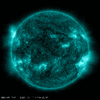Denise Christ drove out to the coastline at 8 a.m. on a recent morning, scanning the horizon for a sick
sea lion stranded on the rocks at Kiddie Beach, about 10 miles south of
Ventura. When she found the pinniped, she realized it was accompanied by two other animals that appeared to be dazed and shaking from
seizures, and two more that were already dead and motionless in the sand.
The stranding operations lead for
Channel Islands Marine & Wildlife Institute got to work, setting safety perimeters around the sea lions with signs warning beachgoers to keep their distance. She took photos and recorded assessments of each animal’s physical condition to determine resources needed and the best course of action for their care, including possible transportation to their medical facility.
By the time Christ was finished, two more reports of sea lions in distress were already awaiting her response. As she continued her mileslong trek across the shore, seeking out the location of every animal, beachgoers approached to tell her about three or four others in the same vicinity that looked like they were in bad shape — not just sea lions, but short-beaked common dolphins, too. Clusters of the animals floated in the water and smothered the tide line, disoriented and exhausted.
“You can’t help but feel like you are in the middle of a battle zone with sick, dying and deceased sea lions and dolphins everywhere,” Christ said. “The emotional component can be overwhelming at times. We are educating people and consoling children who do not understand what they are seeing. We also feel helpless at times. We want to save every animal and we know we can’t.”
Since mid-May, the volunteer-led nonprofit organization has responded to hundreds of dead and dying marine mammals in the
aftermath of a toxic algal bloom that experts are describing as the largest in Southern California’s recent history, with consistent cases reported from San Diego to Santa Barbara as some forecast models show potential risk of spread to Northern California in the coming weeks. Scientists estimate more than 500 sick and dying sea lions and at least 100 deceased dolphins have washed ashore, but exact numbers have yet to be confirmed because of the sheer scale of the event.
“We’re really just kind of all hands on deck trying to deal with the current situation,” said Justin Viezbicke, marine mammal stranding coordinator for NOAA Fisheries, in a press conference Friday.
Scientists received some clarity on the crisis earlier this week — the first round of test results examined by the National Oceanic and Atmospheric Administration on Monday confirmed the presence of domoic acid in at least 19 dolphins sickened by the bloom, providing evidence of high food web contamination, Viezbicke said.
The agency believes an unusual rate of
coastal upwelling, which occurs most frequently in the spring and summer months as the wind blows from north to south, is the culprit. The phenomenon stirs up nutrients from the cold water deep in the ocean that fuel a type of microscopic algae known as Pseudo-nitzschia. Sea lions and dolphins get sick because squids, sardines and other small fish they prey on pick up the deadly neurotoxin. Then, as the marine mammals consume larger amounts of fish containing
Pseudo-nitzschia, they subsequently ingest higher levels of domoic acid, leading to seizures, brain damage, illness or death, and at times, erratic and aggressive behavior.
An estimated 20 or more sea lions are reported to have bitten surfers, divers and other beachgoers throughout Southern and Central California over the past month, John Warner, CEO of the Marine Mammal Care Center in Los Angeles, said in the press conference. Experts cautioned beachgoers and their pets to steer clear of the animals as the event continues to unfold, and to call NOAA’s stranding network hotline at 866-767-6114 if they see one that appears to be sick.
“With this neurotoxin, they’re not acting normally,” Viezbicke said.
Because so many animals are washing up on beaches across California, rehabilitation facilities throughout Santa Barbara, Ventura, Los Angeles and Orange County have reached maximum capacity, forcing them to leave some of the animals on the beach. In an emergency measure, the city and County of Los Angeles worked with NOAA and the Marine Mammal Care Center to set up a sea lion resting area on the beach near Venice to help cordon the animals off from the crowds over the busy Fourth of July holiday weekend.
Ruth Dover, the managing director of Channel Islands Marine & Wildlife Institute, said cases ramped up early in June. Since then, her organization has been “volunteering nonstop for 10 hours a day in the field” and has responded to more than a thousand reports throughout its 155-mile response range from Ventura County to Santa Barbara County.
“It gets worse each day,” Dover said in an email. “The calls, online reports, emails, and texts come in at an overwhelming rate. With 250-350 reports a day, it is impossible for our small nonprofit organization (and most likely many organizations) to handle this unprecedented volume. … There are cases we cannot get to and this is not because we don’t care. It is because there are too many animals stranding with domoic acid for us to physically respond to in a day.”
It’s currently unclear whether the bloom will spread to the Bay Area. Giancarlo Rulli, a spokesperson for the Marine Mammal Center in Sausalito, said the organization has not yet seen an influx of sick animals; only a handful of suspected cases have been reported in Monterey County, and one in San Luis Obispo County.
The Marine Mammal Center typically responds to 60 to 80 sea lions impacted by domoic acid poisoning each year, but those numbers surged to more than 200 animals in 2009, 2014 and 2015 during blooms that were tied with
El Niño patterns and warm water conditions off the West Coast. Rulli said its veterinary team is investigating new therapies to reduce the amount of inflammation and damage a sea lion’s brain experiences while it is recovering from the neurotoxin, and the organization remains prepared should the bloom move farther north.
It’s worth noting this algal bloom is
different than the one that killed thousands of fish in San Francisco Bay last year. That strain of algae, Heterosigma akashiwo, is among the species that can cause blooms known as red tides, and typically impact species like sturgeon, striped bass and bat rays, which suffocate due to lack of oxygen as the algae decomposes. The bloom seen in the bay was also likely caused by a lack of wind, resulting in unusually warm, still waters.
Conversely, the current bloom in Southern California, Pseudo-nitzchia australis, is wind-driven and primarily impacts marine mammals at the top of the food chain, though it appears to be impacting more dolphins than usual because it’s happening so far off shore.
Forecast maps by the Southern California Coastal Ocean Observing System show the outbreak may ease in the Santa Barbara area, but projections indicate a statewide risk. Clarissa Anderson, the executive director of SCCOOS, said that even if the toxic bloom reaches Northern California, it won’t necessarily harm marine mammals at a rampant scale because their prey needs to consume the algae containing the neurotoxin in order for it to work its way up the food chain, which doesn’t always occur.
“You need that intersection of animals feeding on the right vectors at the right time in the mix of water for this to happen,” Anderson explained.
Domoic acid poisoning is not harmful to people or pets unless they consume crabs or shellfish that have been infected with it. However, people are advised to stay out of the ocean if they notice any dense discoloration due to risk of irritation from any chemicals that may be produced by the algae or other related biological activity in the water, said Vanessa Zubkousky-White, a senior environmental scientist for the California Department of Public Health. Commercial shellfish are closely monitored by the state to ensure they are safe to eat, and any new health advisories that may arise from the bloom will be shared on the CDPH’s
marine biotoxin monitoring program website.
There is no antidote or specific treatment for domoic acid poisoning in animals, but sea lions taken in by wildlife rehabilitation centers are typically given anticonvulsant medications to control seizures and kept hydrated to help flush the neurotoxin out of their bodies. Dr. Lauren Palmer, a staff veterinarian for the Marine Mammal Care Center in Los Angeles, said the longer the bloom goes on, the more the prognosis for treatment narrows.
“What we are seeing now is that the animals that are coming in now are in worse condition,” Palmer said. “They’re thinner. They seem to not be as responsive to the anticonvulsant medications and they’re not turning around as quickly. We don’t have as much time.”
Despite how inundated clinics are, experts are calling on the public to reach out for help whenever they see a sick sea lion or dolphin in order to increase its chances of survival. Meanwhile, ongoing tests of affected animals will help determine how the toxin is spreading and determine whether other factors are at play.
“I have never seen anything this intense in terms of the numbers of animals in my 20 years of responding to strandings in this area,” said Michelle Berman Kowalewski, founder and director of the Channel Islands Cetacean Research Unit, which has been collecting and examining samples from the animals. “We are trying to learn as much as we can as fast as we can. As difficult as it is to see these animals die, we want to gather information to help understand how and why this is happening the way it is.”







